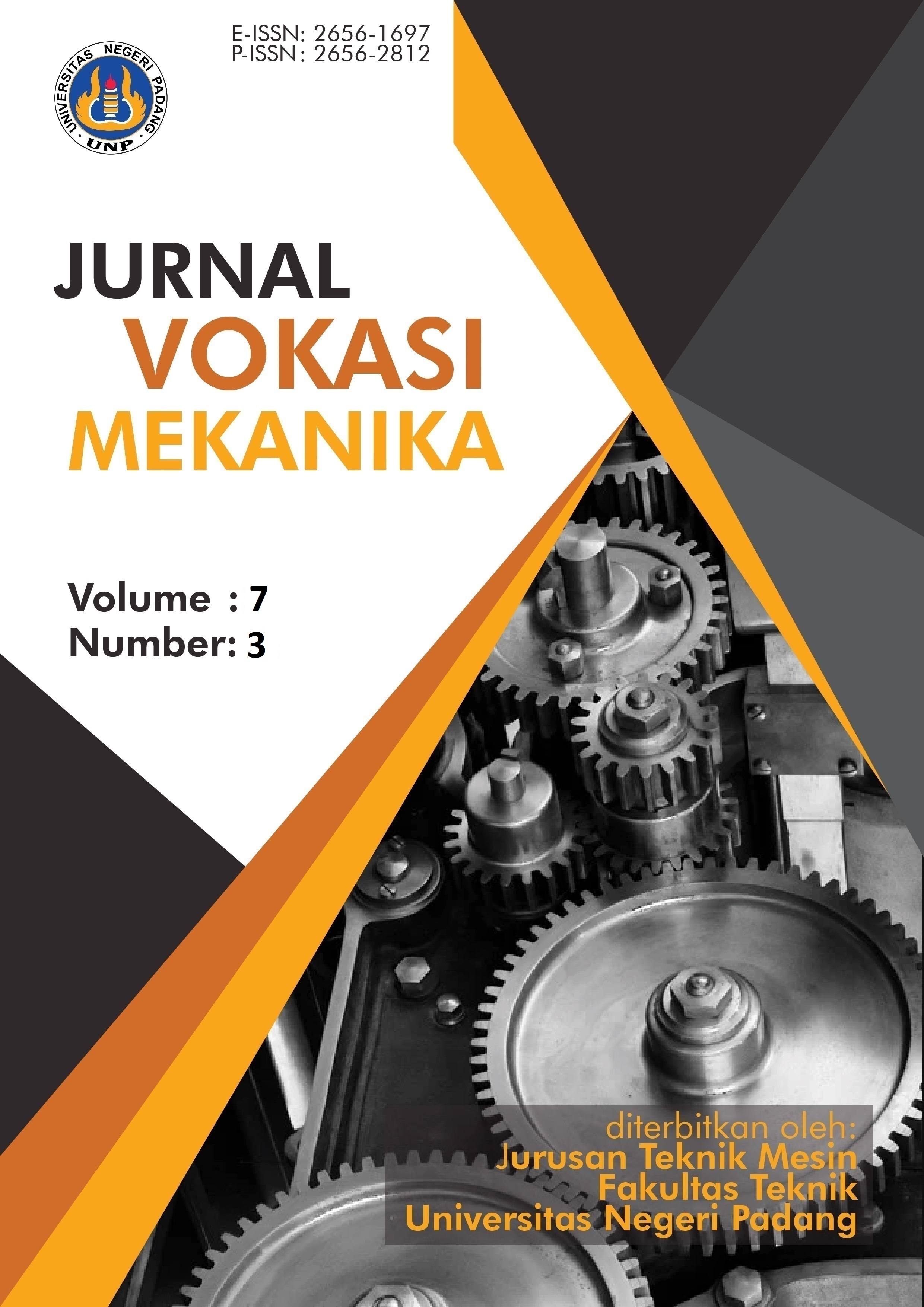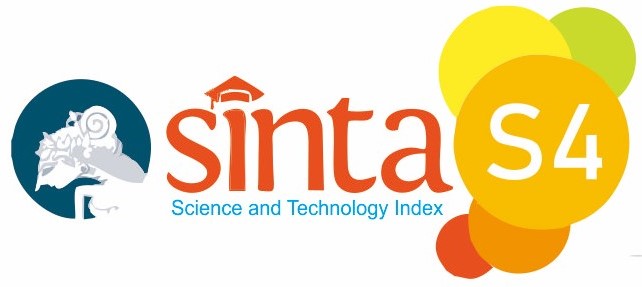Analysis of the Effect of 90° Pipe Elbow Design Variations and Inlet Flow Velocity on Pressure Drop Using Computational Fluid Dynamics Simulation
Abstract
Most industrial processes utilize fluids as a medium for as a medium for transporting materials, both liquid and gas. Pipes as one of the channel components for fluid distribution are often difficult to avoid in their placement. Pressure drop often occurs in pipe bends which can reduce system efficiency. This study aims to examine the effect of variations in 900 pipe elbow design and velocity inlet on pressure drop. The method in this research is the Computational Fluid Dynamics method on Ansys Fluent 2024 R2 Student version software. In this study, 3 elbow pipe designs with the same pipe diameter and connection position dimensions were compared. The connection process is carried out at the same height so that gravity is treated in the same position. The results of this study show that elbow design 1 has the smallest pressure drop value compared to the other two elbow designs. This is clearly seen in the simulation results of pressure drop values, velocity magnitude vectors profiles, visualization of contours statics pressure and velocity magnitude. The conclusion of this research is that the pressure drop value is strongly influenced by elbow design and velocity inlet. If the velocity inlet increases, the pressure drop value also increases. While in the elbow design if the sharper the turn angle, the greater the pressure drop value will be. Based on the resulting pressure drop value, elbow 1 design is more efficient than the other two elbow designs because it has a lower pressure drop value.
References
Aiman, Y., Mariam, S., Musa, M. N., & Syahrullail, S. (2020). Air Flow Analysis and Effect of Angle on Rotation Vane Blade Trough 90° Pipe Bend. IOP Conference Series: Materials Science and Engineering, 884(1). https://iopscience.iop.org/article/10.1088/1757-899X/884/1/012100/pdf
Akbar, M. K., Roihatin, A., & Aulia, N. F. (2024). Computational Analysis Of Pipe Bend Angle Effect On Pressure Drop. Jurnal Polimesin, 22(1), 57–62. http://e-jurnal.pnl.ac.id/polimesin
Cengel, Y. A., & Cimbala, J. M. (2018). Fluid Mechanics Fundamentals and Applications.
Crane Co. (2018). FlowofFluids-ThroughValveFittingsandPipes. In Flow of Fluids Through Valves, Fittings and Pipe (Metric).
Damanik, D. A., Simanjuntak, K., Handika Sinaga, H., Simangunsong, K. A., Silitonga, L. C., Nainggolan, R., Ibrahim, H., & Alfansuri, M. (2022). SINERGI Polmed : Jurnal Ilmiah Teknik Mesin Info Artikel. Sinergi Polmed, 03, 35–42. https://ojs.polmed.ac.id/index.php/Sinergi/article/view/743
Debtera, B., Sundramurthy, V. P., & Neme, I. (2021). Computational Fluid Dynamics Simulation and Analysis of Fluid Flow in Pipe: Effect of Fluid Viscosity. Article in Journal of Computational and Theoretical Nanoscience, 17. https://www.researchgate.net/publication/351513151_Computational_Fluid_Dynamics_Simulaton_and_Analysis_of_Fluid_Flow_in_Pipe_Effect_of_Fluid_Viscosity
Dutta, P., Saha, S. K., & Nandi, N. (2015). Computational study of turbulent flow in pipe bends. International Journal of Applied Engineering Research, 10(11), 10128–10133. https://www.researchgate.net/publication/282950530_Computational_study_of_turbulent_flow_in_pipe_bends
Fadhli, & Sriwati. (2017). Studi Eksperimental Pengaruh Variasi Belokan Pipa (Elbow) Terhadap Kecepatan Aliran Fluida. ILTEK, 12(1), 1. https://media.neliti.com/media/publications/326066-studi-eksperimental-pengaruh-variasi-bel-f59658bf.pdf
Garimella, R. V., Kim, J., & Berndt, M. (2014). Polyhedral Mesh Generation and Optimization for Non-manifold Domains. In Proceedings of the 22nd International Meshing Roundtable (pp. 313–330). Springer International Publishing. https://link.springer.com/chapter/10.1007/978-3-319-02335-9_18
Joshi, T., Parkash, O., & Krishan, G. (2022). CFD modeling for slurry flow through a horizontal pipe bend at different Prandtl number. International Journal of Hydrogen Energy, 47(56), 23731–23750. https://www.sciencedirect.com/science/article/abs/pii/S0360319922023345
Lamsal, A. (2023). Analyzing Pipe Flow Scenarios using Computational Fluid Dynamics (CFD). In International Journal of Engineering Applied Sciences and Technology (Vol. 8). https://www.researchgate.net/publication/374536063_Analyzing_Pipe_Flow_Scenarios_using_Computational_Fluid_Dynamics_CFD
Lemone, M. A., Angevine, W. M., Bretherton, C. S., Chen, F., Dudhia, J., Fedorovich, E., Katsaros, K. B., Lenschow, D. H., Mahrt, L., Patton, E. G., Sun, J., Tjernström, M., & Weil, J. (2018). 100 years of progress in boundary layer meteorology. Meteorological Monographs, 59, 9.1-9.85. https://journals.ametsoc.org/view/journals/amsm/59/1/amsmonographs-d-18-0013.1.xml
Mohanty, C., Nayak, B., & Maharana, P. (2021). Analysis of Pipe Flow for Various Bend Angle using CFD. Juni Khyat Jurnal, 2. http://junikhyatjournal.in/no_2_Online_21/85.pdf
Momin, M., Rahmani, F., Makki, E., Sharma, M., Giri, J., & Sathish, T. (2024). The impact of 180° return bend inclination on pressure drop characteristics and phase distribution during oil-water flow. Heliyon, 10(2). https://www.sciencedirect.com/science/article/pii/S2405844024002822
Nikmah, A., Amalia, R., & Satrio, D. (2022). Analysis of the Effect of Bend Angle Outlet Main Steam Line on the Steam Flow Characteristic. IOP Conference Series: Earth and Environmental Science, 972(1). https://iopscience.iop.org/article/10.1088/1755-1315/972/1/012064
Parely, R. N., & Sudarma, A. F. (2023). Pengaruh Guide Vanes terhadap Aliran Udara pada Saluran dengan Variasi Kecepatan Aliran Menggunakan Ansys Fluent. Jurnal Sain Dan Teknik, 5(1), 1–12.https://www.researchgate.net/publication/371721696_Pengaruh_Guide_Vanes_Terhadap_Aliran_Udara_Pada_Saluran_Dengan_Variasi_Kecepatan_Aliran_Menggunakan_Ansys_Fluent
Qi, C., Chen, Q., Fourie, A., Zhao, J., & Zhang, Q. (2018). Pressure drop in pipe flow of cemented paste backfill: Experimental and modeling study. Powder Technology, 333, 9–18. https://doi.org/10.1016/j.powtec.2018.03.070
Renzhi, W., & Lei, Q. (2019). Numerical study on flow characteristics and energy loss mechanism in the 90° circular pipe bend. International Conference on Advances in Construction Machinery and Vehicle Engineering (ICACMVE), 403–407. https://ieeexplore.ieee.org/document/8995827
Shabani, S., Abedini, A. A., & Mohammadtabar, A. (2019). The Effect of the Pipe Bending Angle on the Pressure Losses Vane Elbow Pipes. The Asian Review of Civil Engineering, 8(1), 1–8. https://doi.org/10.51983/tarce-2019.8.1.2287
Siswantara, A. I., Syuriadi, A., Irwansyah, R., Gunadi, G. G. R., Kamal, D. M., & Supriyadi. (2025). Analysis of the Effect of Inlet velocity on Pressure drop on Cyclone separator to be used in Pyrolysis system. Journal of Physics: Conference Series, 2972(1), 1–13. https://doi.org/10.1088/1742-6596/2972/1/012016
Submitted
Copyright (c) 2025 Jurnal Vokasi Mekanika (VoMek)

This work is licensed under a Creative Commons Attribution 4.0 International License.








.svg_.png)


